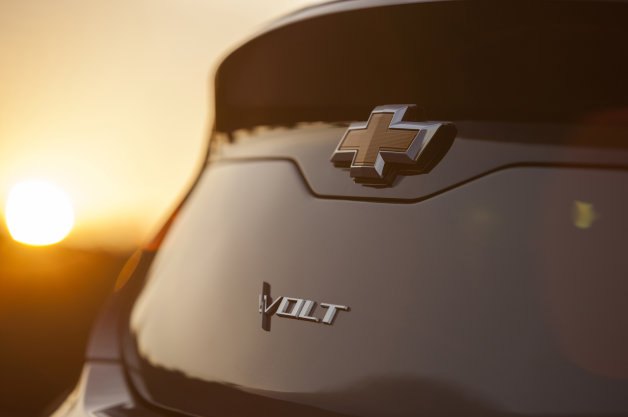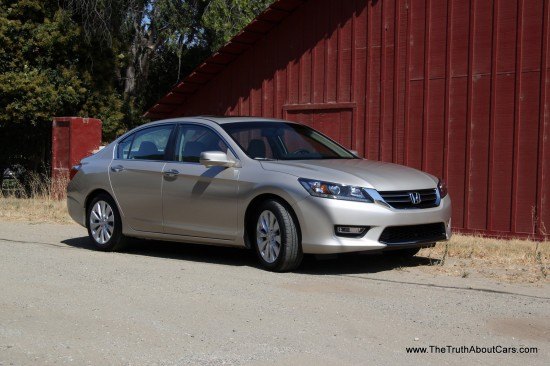#PHEV
NYIAS: Sir Mixalot Called and He Likes Your New Mitsubishi Mirage G4
Mitsubishi today pulled the cover off its new Mirage G4 sedan, which adds a longer wheelbase and a trunk to the occasionally-maligned subcompact, the 2016 New York International Auto Show. As we noted with the restyled hatchback, 4 more horsepower — for a total of 78 — will hum from the Mirage G4’s 1.2-liter three-cylinder engine, and Mitsubishi will make available Android Auto and Apple CarPlay as an option.
2016 Chevrolet Volt Will Debut At Next Edition of NAIAS
The first teaser shot of the Chevrolet Volt has emerged, with the car debuting at the 2015 North American International Auto Show.
Mazda2 RE May Appear Soon, But Only In Select Markets
The oft-rumored Mazda2 RE PHEV, powered by a range-extending rotary engine, may soon become reality, appearing sometime after the next-gen hatch debuts in showrooms between October and the new year.
Pre-Production Review: 2013 Honda Accord – Part 2
Five days ago we released the first part of the 2013 Accord review. It’s not how we normally do things, but in order to get our hands on the second best-selling mid-size sedan in America we had to agree to keep you all in suspense. If you want to know about the new Accord’s drivetrain, interior and infotainment systems, click on over to part one and then head back here when you’re done. I promise we’ll wait for you.
Pre-Production Review: 2013 Honda Accord, Part 1
Redesigning the second best-selling midsize sedan in America is no easy task. It’s also one that doesn’t happen very often for fear of getting it wrong. Still, even with all the bad press the new Civic received, sales have been booming. By all appearances this has not made Honda sit on their hands however when it came to the new Accord. Honda invited us to Santa Barbara to sample the all-new, smaller, 9th generation Honda Accord. This is a bold launch event with not just a new engine and transmission under the hood, but an all new hybrid technology on offer as well. If you want to know how it drives, or how much it costs, our Honda overlords have decreed our lips must be sealed until the 10th at 6AM Eastern. Set yourself a reminder then click-through the jump for part one.
Review: 2012 Toyota Prius Plug-In Hybrid
Public beta tests are common in the computer world where a group of fanatics pound your beta to death and help you find the problems. In the automotive world this activity is not only rare, it runs contrary to the cash spent on dressing future cars in swirly vinyl. The Prius plug-in is different. Toyota built 600 demonstrators and sent them to large corporations, Zipcar fleets and, of course the press. Even TTAC was allowed to drive one for a week. What does that have to do with the final product? And how does it stack up against the Volt, Plug-in Fusion and the 2013 Accord Plug-in? Let’s find out.
Another Plugin Problem: A123 Warns Of "Potential Safety Issue" With Fisker Karma Battery
In the ramp-up to the launch of the Chevy Volt and Nissan Leaf, a great debate seized the engineering community: was Nissan opening itself to problems by not including a active thermal management system for the Leaf’s battery pack, or was Chevrolet’s liquid-cooled approach simply adding unnecessary complexity? Well, thus far, the verdict seems to be in Nissan’s favor. Though Leaf has been troubled by some dissatisfaction with its real-world range, the Volt has endurd the first technical semi-scandal of the plug-in era, when federal regulators found that ruptured coolant lines could cause fires. Now the liquid-cooled approach is hitting its second challenge, as Fisker’s battery supplier A123 Systems is warning in a letter [ PDF] that
some of the battery packs we produce for Fisker Automotive could have a potential safety issue relating to the battery cooling system.
Ruh-roh!
Fisker's Sticker Shock: 32 Miles On Electricity, 20 MPG On Range Extender
The Chevy Volt’s best news in ages broke yesterday when GreenCarReports, er, reported that the Fisker Karma had received EPA approval at 32 miles of EV range, and 20 MPG (combined) thereafter. Moreover, the MPGE (the “e” is for “equivalent”) rating of 52 on electric power is nearly half the Volt’s 94 MPGE rating, suggesting that the Karma is not the most efficient car even in EV mode. And, at nearly 5,600 lbs (per evo.co.uk), you don’t have to look far to find out why. But if you ask Fisker, the problem isn’t the car… the problem is those darn EPA numbers, which you should probably just ignore anyway. After all, nobody drives less efficiently than their car’s EPA numbers, right?
European Market Volt Gets EV-Only "Hold Mode," Should The US Version?
In an era of increasingly-globalized automobiles, the “market-to-market adjustments” which modify a global vehicle to “local tastes” are becoming an interesting source of insight into a company’s perspective. And Chevrolet Europe boss Wayne Brannon revealed one of the more significant adjustments in recent memory (because nobody reads the press releases), when he told Automotive News [sub]’s Dave Guilford
I just switch it into extended range mode, and I drive on fuel until I get there. When I drive in the little villages and towns, I drive in electric mode.
The reason it was important here is we have cities — like London — where you don’t have to pay a congestion charge if you’re running purely on battery. You save the battery for when you need it.
Gosh, that’s an interesting idea. It would certainly help clear up some of the confusion in the marketplace about why the Chevy Volt is the way it is. Imagine the tagline: “Gas or electric? You decide.” So, how about it, GM? Will that feature come to the US?
Report Knocks "Big Battery" Plug-In Subsidies, Will The DOE Notice?
The main tool for the government’s crusade to get one million plug-in cars on the road by 2015 is the “Qualified Plug-In Electric Vehicle Tax Credit,” a credit that returns between $2,500 and $7,500 to purchasers of a qualifying vehicle. To qualify for the minimum $2,500 credit, a vehicle must have a traction battery with a minimum of four kW/h, and the credit adds an additional $417 in credits for every kW/h above the minimum. Why? Well, you might think that it’s because the DOE has done its research and determined that larger battery packs deliver more social benefits… at least until the 16kW/h limit (the exact size of the Chevy Volt’s battery), where the credit tops out at $7,500. But according to new research by Carnegie Mellon’s Jeremy Michalek, that basic assumption doesn’t appear to be true at all. In fact, his latest paper argues that the government would actually be better off subsidizing smaller, not larger, battery packs.
Truth Versus Advertising: Sex Is Sexier Than The Environment Edition
With the environment taking an ever-larger place in automotive advertising, it’s interesting to note that Fisker’s latest brochure puts green in its place: behind sexy. Of course these sultry images [via BusinessInsider] aren’t free from environmental overtones, featuring taglines like “designed to get you hot, not the planet,” but it’s clear that Fisker is more heavily relying on the most traditional tool in the advertising playbook. Why? For one thing, even though Fisker is delivering Karmas, the EPA has not yet certified its efficiency rating… so we don’t even know how environmentally friendly it is yet. For another the Karma’s main rival, Tesla’s forthcoming Model S, is pure electric and therefore more appealing to wealthy environmentalists. Finally, unlike environmental messaging, sex doesn’t remind people that Fisker was the beneficiary of over half a billion dollars in government loans. Plus, sex is still, well, sexy. The more things change, the more they stay the same…
2011 Chevrolet Volt: Take Three
Truth seeking is difficult considering the controversy, misinformation and flat-out lies surrounding the Chevrolet Volt. But this is a product with set attributes, some are better or worse than our collective expectations. The performance reminds me of live music: everyone has an opinion as to how much it rocked. And the Chevrolet Volt is Jimi Hendrix on wheels: an American likely to influence popular culture for decades after leaving the limelight. But more importantly, like the influences of jazz and blues in Jimi’s work, the Volt combines Detroit’s future with memorable elements of the past. It’s true.
The Curse Of The Theta Plug-In: Cadillac SRX PHEV Dies
Three times now, GM has planned to build a plug-in hybrid (PHEV) version of its Theta-platform crossovers, once with the Saturn Vue, once with the Buick “Vuick” and now, according to Reuters
General Motors Co has canceled plans to develop a plug-in hybrid vehicle based on the current Cadillac SRX crossover platform, deciding the project was not financially viable, three people with direct knowledge of the project said.
While two of the sources said the plans could still be revived on a future platform, they and two others familiar with the matter said engineers involved had been reassigned to other projects.
Back in early days of the program, the plan was to bring a Vue PHEV to market as soon as 2010, but the death of Saturn (and other difficult-to-identify issues) forced a change of plans. The Buick version was literally laughed out of consideration in what was the first-ever Twitter-based future product killing. But given that hand-picked members of the public were driving mules nearly two years ago (see video), we figured enough development had been done that GM essentially had no choice but bring the troubled Theta PHEV to market. Today’s cancellation of the SRX version is therefore just a little confusing…
How Efficient Are Plug-In Cars? Survey Says…
A number of plug-in hopeful firms have been testing their future products in fleets, keeping a close eye on the data coming back as they prepare for their consumer launches or wider availability. One such vehicle, Toyota’s plug-in Prius has been testing for some time now, and while the results of US and European testing hasn’t been publicized yet, Wards Auto reports that the company has disclosed the results of Japanese testing with some interesting conclusions. With BYD and Chevrolet releasing data from their own plug-in testing, we should have the basis for some interesting insights. Hit the jump for more on the lessons learned and the data gleaned from this testing of next-gen drivetrains.
Quick Review: Toyota Prius Plug-In
It’s not every day that an automotive blogger gets to drive the future of transportation, a radical rethinking of how we interact with our private transport, and yet that’s exactly what I recently did. And no, I’m not talking about the Prius Plug-In Hybrid (PHEV)… that’s just a Prius with some larger batteries and re-worked software. No, what makes our time with this particular Prius noteworthy is that it isn’t technically private transport. Welcome to the future: the public plug-in hybrid (PPHEV).

























Recent Comments